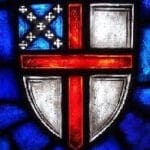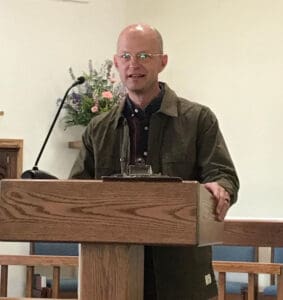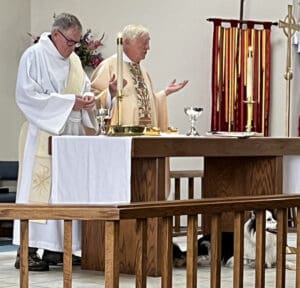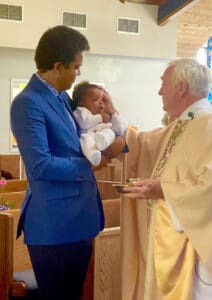Worship at St. Mary's
Ancient traditions. Powerfully relevant.Walking into a new church can be bewildering for even the most seasoned church-goer. Recognizing that you can never get a feel for a place until you experience it in person, we hope the basic information below will make your first visit more comfortable. Remember, no one will give you odd looks if you stand when you’re supposed to sit or kneel when you’re supposed to stand!
Episcopalians’ principal weekly worship service is the Holy Eucharist (also known as Holy Communion, the Lord’s Supper, or the Mass). You will experience this service when you worship with us on a Sunday morning.
9:00 am Holy Eucharist, Rite II – This is liturgy with choir, organ, and piano music.
A St. Mary’s usher will greet you with an easy-to-follow paper service bulletin referencing pages we will use in the Book of Common Prayer and hymn numbers from Hymnal. The Book of Common Prayer is a red book with a cross on the cover found in all pews. The blue Hymnal contains our service music and hymns and is also in the pews. A green praise songbook is used occasionally and located at the ends of the pews.
Liturgy and The Book of Common Prayer
Worship in the Episcopal Church is said to be “liturgical,” meaning that the congregation follows a service format and prays from texts that don’t change significantly from week to week during a season of the year. This sameness gives worship a rhythm that becomes both familiar and comforting to worshipers.
For the first-time visitor, liturgical worship may be exhilarating… or confusing. Standing, sitting, kneeling, singing or speaking responses, and other participatory elements may initially seem daunting. However, liturgical worship can be compared with a dance: once you learn the steps, you appreciate the rhythm, and it becomes satisfying to dance repeatedly as the music changes.
The service of the Holy Eucharist always has the same two major components: The Liturgy of the Word and the Liturgy of the Table.
The Liturgy of the Word
The service begins with The Liturgy of the Word, a set of Bible readings interspersed with hymns or psalms. One reading is always from the Gospels (Matthew, Mark, Luke or John). Next, a sermon is preached, interpreting the appointed readings, and then the congregation recites the Nicene Creed, written in the 4th Century, which remains the Church’s statement of what we believe.
Next, the congregation prays for the Church, the world, and those in need. We pray for the sick, thank God for all the good things in our lives, and finally, we pray for the dead. The priest concludes with a prayer that gathers the petitions into a communal offering of intercession.
In certain seasons of the Church year, the congregation formally confesses their sins before God and one another. This is a corporate statement of what we have done and what we have failed to do, followed by a pronouncement of absolution. In pronouncing absolution, the priest assures the congregation that God is always ready to forgive our sins.
The congregation then greets one another with a sign of “peace.” This manifests itself in parishioners greeting one another in nearby pews. Then comes a brief time for Parish Announcements – some refer to this as the liturgical “halftime.”
The Liturgy of the Table
Next begins the second half of the service, the Liturgy of the Table. The celebrant (the priest leading the service) stands at the table, which has been set with a cup of wine and a plate of bread or wafers, raises his or her hands, and greets the congregation again, saying, “The Lord be With You.”
Now begins the Eucharistic Prayer, in which the celebrant tells the story of our faith, from the beginning of Creation, through choosing Israel to be God’s people, through our continual turning away from God, and God’s calling us to return. Finally, the celebrant tells the story of the coming of Jesus Christ and about the night before his death, on which he instituted the Eucharistic meal (communion) as a continual remembrance of him.
The celebrant blesses the bread and wine, and the congregation recites the Lord’s Prayer. Finally, the bread is broken and offered to the congregation as the “gifts of God for the People of God.” The congregation then shares the consecrated bread and the wine.
At St. Mary’s, we come to the altar, as directed by the ushers, and many receive bread first by crossing their hands palms up. You may choose to sip from the chalice or leave the bread in your hands for the server to dip it into the chalice. This is called Intinction and is another method of receiving communion, whereby one receives the bread and wine together. It is also perfectly acceptable to receive communion in one kind only (bread). St. Mary’s offers both alcohol-free wine and gluten-free bread. Just ask the server.
Wherever you are in your journey of faith, you are welcome at the Lord’s Table here at St Mary’s. We say, “Come to this table, you who have much faith and you who would like to have more; you who have been to this sacrament often, and you who have not been for a long time. You who have tried to follow Jesus, and you who have failed. Come. It is Christ who invites you to meet him here.”
You are also welcome to come forward during the Eucharist to receive a blessing without receiving the Communion. You can indicate this by crossing your arms across your chest as the priest approaches.
At the end of the Eucharist, the congregation prays once more in thanksgiving, and then is dismissed to continue the life of service to God and to the World.
Resources
The (on-line) Book of Common Prayer; A private transcription of the 1979 Book of Common Prayer.
The Lectionary Page; The list of scripture readings appointed for the current Church season.



